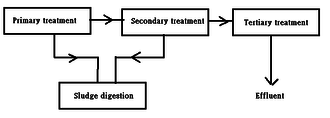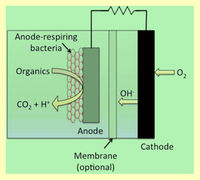Role of microorganisms in Sewage Treatment: Difference between revisions
Timothyjou (talk | contribs) (Created page with " By: Timothy Jou <br> =Introduction= <br> [[File:First_image.png|330px|thumb|right|Figure1: general scheme of sewage treatment which shows the flow from primary treatment to t...") |
Timothyjou (talk | contribs) No edit summary |
||
| Line 1: | Line 1: | ||
By: Timothy Jou | By: Shi-Chun(Timothy) Jou | ||
<br> | <br> | ||
=Introduction= | =Introduction= | ||
Revision as of 08:07, 29 November 2013
By: Shi-Chun(Timothy) Jou
Introduction
Sewage treatment is a process in which the pollutants are removed. The ultimate goal of sewage treatment is to produce an effluent that will not impact the environment [1] . In the absence of sewage treatment, the results can be devastating as sewage can disrupt the environment.
The general processes of sewage treatment are primary, secondary and tertiary treatment. Primary treatment involves physical separation of sewage into solids and liquid by using a settling basin. The liquid sewage is then transferred to secondary treatment which focuses on removing the dissolved biological compound by the use of micro-organisms. The micro-organisms usually use aerobic metabolism to degrade the biological matter in the liquid sludge. Then tertiary treatment is required to disinfect the sewage so that it can be released into the environment. The solid sewage separated from primary treatment is transferred to a tank for sludge digestion which involves anaerobic degradation using micro-organisms [2].
physical environment

The environment of the sewage treatment plant has to be controlled precisely because bacteria are sensitive to the oxygen level, pH level, temperature, and level of nutrient. In order for efficient degradation of biological matter to occur, these factors are controlled manually.
Sewage composition
Sewage is composed of organic matter such as carbohydrates, fats, oil, grease and proteins mainly from domestic waste. It also contains dissolved inorganic matter such as nitrogen species and phosphorous species mainly from agricultural use [3]. It is essential to remove the nutrients before they are released to the environment because it interferes natural habitats by altering the chemical composition such as pH or oxygen level both directly and indirectly.
Oxygen level
Oxygen level is an important factor to secondary and tertiary treatment processes. Secondary treatment, oxygen is required as a terminal electron acceptor in organic matter degradation. For example, nitrification by Nitrosomonas and Nitrobacter species requires dissolved oxygen to occur [4]. Oxygen in secondary treatment is provided manually by pumping oxygen into the sewage continuously which occurs in an aeration tank [5]. In tertiary treatment, the removal of excess organic matter is enhanced by settling the sewage in a lagoon. This process is also aerobic, but it depends on the diffusion of oxygen because most organic matter has been degraded by secondary treatment [5].
pH
Acidity plays a crucial role in the breakdown of organic matter because pH affects the solubility of compounds which indirectly affect the accessibility by bacteria [8]. Also, bacteria responsible for organic matter degradation are sensitive to the pH of the environment. Extremely high or low pH levels are able to kill bacteria, deposition of organic matter occurs due to lack of degradation [6]. Hence, the pH of sewage treatment is controlled to be around 7. A nitrifier in secondary treatment, Nitrosomnas requires a pH between 6~9 in order to be viable [7].
Temperature
The effect of temperature is influential for secondary treatment, but it is not important in primary treatment. Bacterial growth is sensitive to temperature because high temperature can increase the fluidity of the phospholipid bilayer which leads to cell lysis. However, bacteria are known to have higher enzymatic activity at higher temperature because of increased thermal energy. For example, when thermophilic sludge treatment is compared to mesophilic treatment, the sludge biodegradability is higher with thermophilic degradation [9]. Hence the temperature has to be controlled precisely to maximize the efficiency of degradation but also allow the cell to remain viable.
Nutrients availability
There are a lot of nutrients available in the sewage because of human waste and agricultural runoff [3]. Bacteria can harvest the electron from organic matter and transfer it to a terminal electron acceptor which results in the break down of organic matter and energy conservation [10].
Microbial processes
There are several microbial processes, and the microbial processes can be catergorized into aerobic and anaerobic.
Aerobic
After primary treatment, liquid and solid phases are physically separated. The liquid phase is treated with aeration to allow aerobic degradation of the nutrients. The two important microbial processes at this stage are nitrification and phosphorous removal. Nitrification occurs in two discrete steps. First of all, ammonium is oxidized to nitrite by Nitrosomonas.spp, and nitrite is further oxidized to nitrate by Nitrobacter.spp [4]. Phosphorous removal can occur biologically by the process of “enhanced biological phosphorous removal.” The process is demonstrated by the cell taking up phosphorous within their cell, and the biomass is filtered [11].
Anaerobic
In the liquid component of sewage, denitrifying bacteria reduce nitrate into dinitrogen gas which liberates nitrate from the sewage [13]. The solid component of the sewage separated in primary treatment is fermented by bacteria anaerobically [12].
Key microorganisms
Microorganiasms can also be categorized by its metabolism.
Microorganisms with aerobic microbial process
Members of the Nitrosomonas genus is a gram negative bacterium responsible for the first stage of nitrification in sewage. They oxidize ammonium into nitrite. This bacterium prefers a pH around 6-9 and nitrify optimally at 20-30°C [4].
Members of the Nitrobacter genus is a gram negative bacterium responsible for the second stage of nitrification in the sewage. It oxidizes nitrite to nitrate using oxygen as a terminal electron acceptor. The bacteria has an optimum pH of 6~8, and an optimum temperature of 0~40°C [4].
Microorganism with anaerobic microbial process
Members of Pseudomonas genus is a gram negative denitrifying bacteria that use the chemical energy in organic matter to reduce nitrate into dinitrogen gas [14]. Also, members of the bacteroidetes phylum are the gram negative bacteria responsible for the anaerobic fermentation of the solid sludge [12].
Current Research
A research has shown the correlation between nutrient removal efficiency, light wavelength and light intensity. Xu et al. discovered that red and high intensity light maximizes the nutrient removal efficiency [15]. Also, the use of pre-treated sludge is found to generate electricity in a microbial fuel cell [16]. This can potentially lead to production of renewable energy.
References
(1) Zhao, H., Duan, X., Stewart, B., You, B., Jiang, X., “Spatial correlations between urbanization and river water pollution in the heavily polluted area of Taihu Lake Basin, China.” Journal of Geographical Sciences, 2013, 23(4):735-752. (2) Canler, J.P., Perret, J. M., “Biological aerated filters: assessment of the process based on 12 sewage treatment plants.” Water Science and Technology, 2011, 29:13-22.
(3) Painter, H. A., and Viney, M., “Composition of a domestic sewage.” Biotechnol. 1959, 1: 143–162. DOI: 10.1002/jbmte.390010203
(4) Wagner, M. “in situ analysis of nitrifying bacteria in sewage treatment plants.” Water science and technology, 1996, 1: 237-244.
(5) E. Hurwitz. And Wm. A. Dundas., “Wet oxidation of Sewage Sludge.” Water Pollution Control Federation, 1960, 32(9):918-929.
(6) Haandel, A. C., Lettinga, G. “Anaerobic sewage treatment: a practical guide for regions with a hot climate.” Bioenger, 1994, 1:174-180.
(7) Etinger-Tulczynska, R. “A comparative study of nitrification in soils from arid and semi-arid areas of Israel.” Journal of Soil Science, 1969, DOI: 10.1111/j.1365-2389.1969.tb01579.x.
(8) Vieno, NM, Tuhkanen, T, Kronberg, L. “Analysis of neutral and basic pharmaceuticals in sewage treatment plants and in recipient rivers using solid phase extraction and liquid chromatography-tandem mass spectrometry detection.” Journal of Chromatography. 2006, 1134: 101-111, DOI: 10.1016/j.chroma.2006.08.08.077.
(9) Meabe, E., Déléris, S., Soroa, S., and Sancho, L., “Performance of anaerobic membrane bioreactor for sewage sludge treatment: Mesophilic and thermophilic processes.” J. Membr. Sci., 2013, 446: 26-33, DOI: 10.1016/s.memsci.2013.06.018.
(10) Renuka, N., “Nutrient sequestration, Biomass production by microalgae and phytoremediation of sewage water. ” International Journal of Sewage Water, 2013, 8:789-800.
(11) Zou, H., “Investigation of Denitrifying Phosphorus Removal Organisms in a Two-Sludge Denitrifying Phosphorus Removal Process.” Asian Journal of Chemistry, 2013, 12:6826-6830.
(12) Hernon, F., Forbes, C., and Colleran, E., “Identification of mesophilic and thermophilic fermentative species in anaerobic granular sludge.” Water Sci Technol, 2006, 54(2): 19-24.
(13) Chen, K., and Lin, Y., “The relationship between denitrifying bacteria and methanogenic bacteria in a mixed culture system of acclimated sludges.” Walter Res, 1993, 27:1749-1759, DOI: 10.1016/0043-1354(93)90113-V.
(14) Salla, AK., Abu-Alteen, KH., and Jafri, Am., “Enumeration of Pseudomonas species and Pseudomonas aeruginosa bacteriophages in domestic sewage.” Micriobios, 1989, 60(242):35-43.
(15) Xu, C., Cheng, P., Yan, C., Pei, H., and Hu, W., “The effect of varying LED light sources and influent carbon/nitrogen ratios on treatment of synthetic sanitary sewage using Chlorella vulgaris.” World Journal of Microbiology and Biotechnology, 2013, 29(7): 1289-1300.
(16) Mohd Yusoff, MZ., Hu, A., Feng, C., Maeda, T., Shirai, Y., Hassan, MA., Yu, C., “Influence of pretreated activated sludge for electricity generation in microbial fuel cell application.” Bioresour Technol, 2013, 145:90-96, DOI:10.1016/j.biortech.2013.03.003.
(17) Heukelekian, H., and J. L. Balmat. "Chemical composition of the particulate fractions of domestic sewage. " Sewage and Industrial Wastes, 1959, 31: 413-423.
(18) Lovley, Derek R. "Microbial fuel cells: novel microbial physiologies and engineering approaches." Current opinion in biotechnology, 2006, 17: 327-332.


